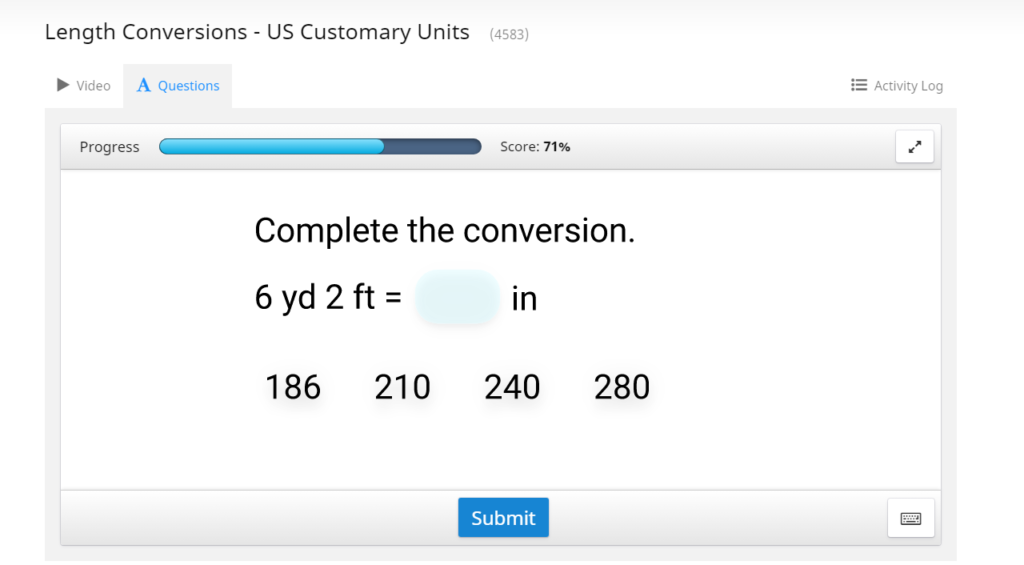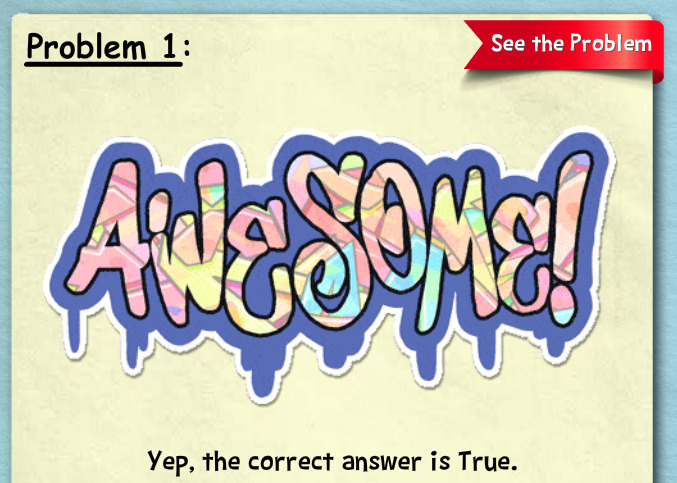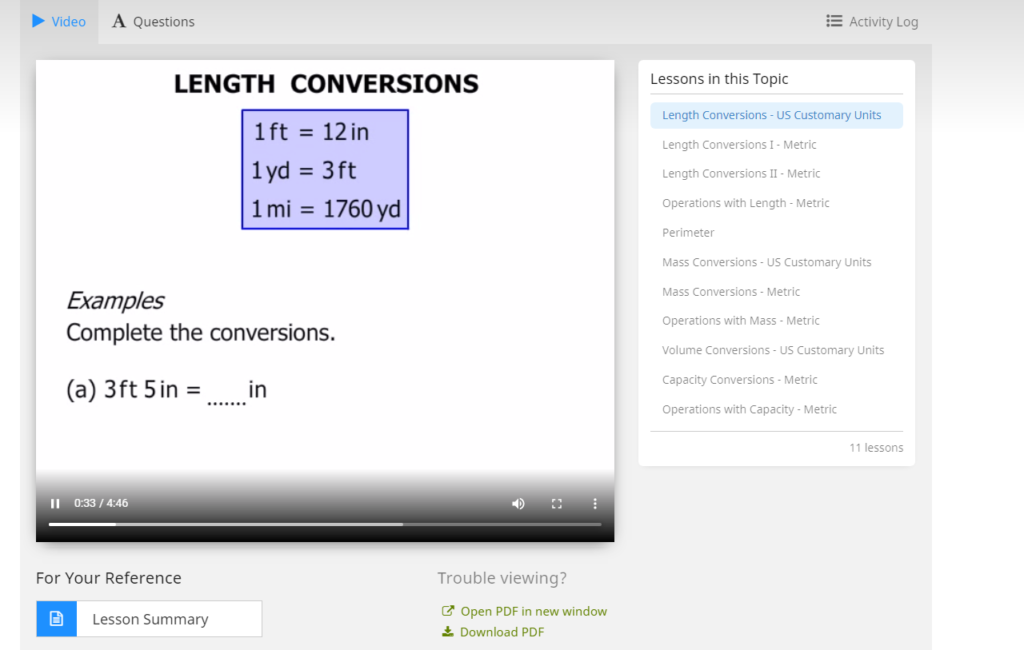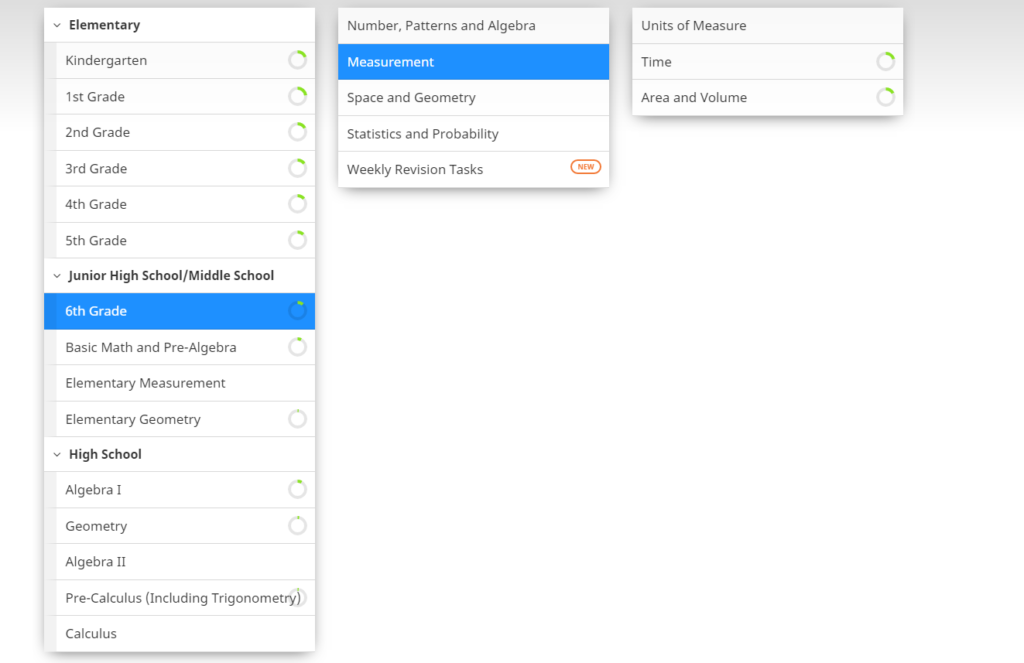As reluctant as we might be to admit it, not every homeschooling parent has the time to be able to sit with their student and teach math.
Similarly, not every parent feels comfortable enough with their own math skills to tackle a subject as important as math, especially at the upper levels.
For these parents, a self-study homeschool math program can be a lifesaver.
CTCMath and Teaching Textbooks are two great digital, self-study choices for teaching math that are quite popular with homeschoolers and have long track records for success.
Due to their respective, strong reputations, it can be hard for parents to choose between these two, seemingly similar, math programs.
To help out, we decided to compare CTCMath and Teaching Textbooks so that parents can make an informed decision about which might be best for their student.
What is CTCMath
CTCMath is a self-study, full online homeschool math curriculum for students that teaches K-12 math through a series of online video lessons, digital review materials, interactive practice questions and automatically graded quizzes and exams.
An increasingly popular math option for homeschoolers, CTCMath is browser-based and available for most computers and mobile devices.
What is Teaching Textbooks
Teaching Textbooks is a fairly well-known full math curriculum for homeschoolers that has made the transition in recent years to a digital format.
The program teaches math for grades 3-12 through instructional videos, ebooks, practice problems, tests and more.
Teaching Textbooks courses are available as a downloadable app and are accessible through most computers, laptops and mobile devices.
Program Access
CTCMath is an online, browser based program, which means students only need to be able to access and log into the website to use it.
It can therefore be used on just about any device, from any location, so long as there is an internet connection and a somewhat modern web browser.
Teaching Textbook, on the other hand, largely runs through a downloadable app.
Each grade or course is purchased separately and comes as its own unique app, which users install.
From time to time information and materials are synced between the app and Teaching Textbooks’ servers, which allows student progress to be saved and updated regularly, allowing students to download and use the app on several devices without losing their place.
The app is broadly compatible with many devices, including Windows, Mac, iOS, Android and Kindle Fire and, because it downloads material and uploads information periodically, it can be used offline as well, which is good for parents who are wary of leaving their child with an internet-connected device.
Advantage: Tie – both programs simply work differently and which is better really depends on individual preference.
Although CTCMath is browser-based, streamlined and doesn’t require any downloading, it requires an internet connection, which isn’t always ideal or possible for some families.
Similarly, Teaching Textbooks is available for work offline and syncs its program pretty well, but requires users to download the app and needs to download and upload files from time to time before progressing.
What Grade Levels Do They Cover
Both CTCMath and Teaching Textbooks are full, college-prep math curricula, and both programs thoughtfully offer free placement tests that can help parents figure out where to begin.
That said, CTCMath is a full curriculum that spans the entire K-12 math curriculum, up to and including Calculus.
Teaching Textbooks, on the other hand, covers Grades 3-12, up to and including pre-Calculus.
CTCMath, therefore, is a bit more comprehensive math program in terms of grade levels and courses, being able to be used to teach Kindergarten and Grades 1-2 math as well as High School Calculus.
Similarly, a subscription to CTCMath provides parents and students with access to all grades and courses, allowing students to freely revisit previous course material or move further ahead, depending on their progress or needs.
Teaching Textbooks, however, works on a course-by-course basis, with each student signed up and tethered to particular grades that correspond to their own unique app.
As a result, students have less flexibility in moving from grade to grade without purchasing a new course.
Advantage: CTCMath
Approach To Teaching Math
CTCMath and Teaching Textbooks are both self-study math programs.
They both do a good job at carrying students through their math lessons, i.e. introducing new material, offering practice and periodically quizzing them on it.
They both also automate many of the administrative tasks involved in teaching math (corrections, grading, etc), reducing the overall burden on homeschooling parents a little bit.
In terms of their method of teaching, CTCMath and Teaching Textbooks also have some similarities in approach.
While they both do a good job at explaining math clearly and concisely, and do discuss the reasoning behind math to a fair degree, they both tend to focus more on teaching students how to solve math problems quickly and efficiently, with an emphasis on practical math and solving problems, rather than spending a great amount of time discussing why or exploring multiple approaches to problem solving.
They do have their differences in how they structure their curricula, however.
CTCMath is a mastery math curriculum. It tends to tackle concepts one at a time, diving into them in considerable depth until a student reaches a certain level of skill and understanding before moving on.
With mastery, students will spend more time on one concept, allowing students to really dig into a single topic and explore it at their own pace.
For some students, this can make math a far less frustrating experience, as they can really spend time getting a deep understanding of what they are working on.
Teaching Textbooks, on the other hand, is a spiral curriculum.
Like a traditional math classroom, it breaks concepts down into smaller topics, teaches a little at a time and then comes back to revisit them in greater depth later, linking new concepts to previously learned material.
In a spiral approach, students are exposed to a wider variety of math topics in a given time period, are better able to see how the pieces of math fit together as part of a bigger picture, and tend to review topics more frequently, which can help with retention for some students.
Advantage: Tie – it depends on student preference.
CTCMath Vs Teaching Textbooks: How do they Teach
Video Lessons
Both CTCMath and Teaching Textbooks use an audio/visual approach to teach math concepts, mainly through the use of videos.
For both programs, these videos are recorded and take place on a digital whiteboard, with the instructors demonstrating concepts and working out solutions step by step right on the screen.
Recognizing the rather limited attention spans of their audience, both CTCMath and Teaching Textbooks keep each of their videos short and to the point, typically under 10 minutes.
An example of CTCMath lesson can be found in the video below.
While below is an example of a Teaching Textbooks lesson:
As can be seen, both programs are engaging and explain math fairly clearly and tend to use a lot of on screen visuals and diagrams.
In our opinion, CTCMath tends to explain math in a bit more of a straightforward and traditional manner, with more standard diagrams and charts, while Teaching Textbooks tends to use a little more sound effects, animations and in-lesson questions and actions.
Which is better ultimately depends on the child.
If the student prefers a more serious and to-the-point approach to math (or get annoyed by animations and a cartoon feel to their lessons), they may prefer CTCMath lessons.
If a student is intimidated by math or has trouble keeping focus during lessons they may prefer Teaching Textbooks and its more colorful approach.
One thing that does stand out with Teaching Textbooks is that it offers parents and students the ability to access complete ebooks of their coursework, an option that can help with review or for students who prefer to learn by reading as well as by lecture.
In contrast, CTCMath provides 1-2 page summaries that are accessible in each lesson, but which aren’t as comprehensive as a full textbook.
Advantage: Tie – it depends on student preference.
Online Practice
Following the video lessons, both CTCMath and Teaching Textbooks reinforce what has been learned through a series of focused practice questions covering the new material.
CTCMath offers several opportunities for practice for each lesson. There is a series of 30-40 interactive and worksheet practice problems per lesson.

There are also diagnostic quizzes, which can be done before or after a lesson, and weekly revision tasks that can be assigned, which can also provide a more comprehensive review of previously learned topics (something that is often missing in mastery programs).
Similarly, the program also offers parents access to a question building program, allowing them to freely build and assign their own practice work to students on various topics, should they so choose.
When it comes to practice, CTCMath is a big believer in the pen and paper approach to math.
While students input their answers into the program (either as short response or multiple choice), they are expected to work out problems on scrap paper manually before entering their response into the program.

Teaching Textbooks also offers students a good deal of practice in each lesson.
Each video periodically pauses and challenges students to solve a short problem, which makes the lessons themselves quite interactive.
Following each lesson, students are provided with 20-30 questions on the topic that has just been covered.
Like CTCMath, answers are inputted in the app, but unlike CTC students can actually work things out right in the app.
Teaching Textbooks has an in-built math-oriented drawing program called Scratch Pad, that allows students to do and show their work digitally before submitting an answer, removing the need to work things out with pen and paper.

That said, although perhaps less cumbersome and more high-tech to use, we don’t feel that Teaching Textbooks has the diversity or quantity of practice available on a per lesson basis (at least potentially) that CTCMath does, with its diagnostic tests, interactive problems, question banks, weekly reviews and worksheets.
Advantage: CTCMath
Automatic Grading
In addition to teaching math, both Teaching Textbooks and CTCMath automatically score and keep records of student responses to practice questions, quizzes and tests.
As a result, both minimize the amount of administrative work required of parents and can be real time savers for busy homeschools.
Advantage: Tie
Progress Reports
Both CTCMath and Teaching Textbooks offer progress reporting, allowing parents to keep track of their students’ progress and use of the program.
Both programs let parents know essential information such as which lessons a student has completed, their scores on each lesson and topic, how many questions they got wrong vs right in their practice and their overall usage of the program.
CTCMath’s progress tracking, however, is a little more in-depth overall, allowing parents to get insight into things like how they did on their diagnostic testing, time spent on the program and lessons, how many attempts a student took at each lesson, how they did on each attempt, and allows parents to dive down to the level of individual questions, which provides a more granular understanding of student performance.
Advantage: CTCMath
Rewards and Incentives
Rewards are somewhat controversial in educational programs, with some parents feeling that they provide incentives to otherwise reluctant students, while others feel they can be too distracting and pull kids away from their lessons.
Neither CTCMath nor Teaching Textbooks offer a great degree of in-program rewards or incentives.
There are no online games to win or play in these programs and no prizes or currency to earn as there are with some other programs out there.
With CTCMath, while the website does have some skill-building games students can access as an alternative form of drill and practice, within the main program the focus is mainly on learning.
CTCMath does offer students the ability to earn ribbons and certificates for accomplishments, but otherwise sticks to the learning and leaves praise and rewards to the parent.

Teaching Textbooks offers a little more in the way of in-programs reward. T
The program offers a lot of praise and animations for correct answers and students can collect quirky and fun animated stickers and wallpapers for answering questions correctly.

As a result, it can be a little more useful for students who really need a lot of encouragement and incentives to keep going.
Advantage: Teaching Textbooks
CTCMath vs Teaching Textbooks: Rigor of Curriculum
Both CTCMath and Teaching Textbooks, as we’ve mentioned, are full college-prep curricula that aim to explain math simply and clearly to students of all abilities.
Neither program is aimed at gifted math students or is designed as an enriched program, such as with the Russian School of Math. Art of Problem Solving or similar curricula.
Between the two, however, we feel that CTCMath is the more rigorous math program, with slightly more challenging questions, a deeper question bank and a curriculum that extends into high school Calculus.
Advantage: CTCMath
That said, it’s important to note that rigor isn’t everything.
For students who have had a bad experience in math, are math-phobic or simply dislike math as a subject, Teaching Textbooks’ easier pace and more approachable, encouraging nature can make it more effective and useful.
Look and Feel
When it comes to the look and feel of each program, Teaching Textbooks and CTCMath do differ quite a bit.
CTCMath has a more traditional look to it, with lots of clean space (although background color and some style can be changed) and a fairly straightforward, to the point interface that’s simple but hard to get lost in.

It looks, in short, much as you might expect a math program to look- it works well and is easy to navigate but may not be the most interesting program for younger students to use.
In contrast, Teaching Textbooks has a fairly approachable and very child-friendly appearance, with cartoon characters and a school notebook-like background, can be fun and makes the experience a lot less intimidating to students with a fear of math.

That said, older and more serious-minded students may not appreciate it as much and may prefer CTC’s look.
Interestingly, both programs offer read aloud functions, with CTCMath offering it as an option on each screen and Teaching Textbooks pretty much reading everything aloud by default.
One thing to consider is that, because Teaching Textbooks functions as an app, it does need to sync and download files on occasion from the main server, which means students and parents may need to let it load from time to time, which can annoy less patient children.
Advantage: Tie – each have their own advantages and disadvantages and it depends on student taste and preference.
Price
Note: Prices correct as of writing, all prices in USD.
CTCMath starts at just under $30 per month ($200 per year) per student, while Teaching Textbooks has a more a la carte pricing system, costing between $43.08-67.08 per student per course per year.
Multiple Students and Larger Families
Both CTCMath and Teaching Textbooks have special price offers for families with multiple children.
CTCMath is pretty straightforward, offering complete access to all its courses for larger families for just under $40 per month ($300 per year).
Teaching Textbooks, in contrast, has plans for families of 4-8 children at just under $200 per year, allowing them access to up to 8 courses (1 student per course) for a single yearly price.
In an absolute sense, then, Teaching Textbooks is a more affordable homeschool math program, in that its per year and per month cost per student tends to be lower than CTCMath.
However, it’s important to note that with Teaching Textbooks students are limited to being in one course (grade) of math, and cannot access or make use of other math grade levels.
This means things can get a little tricky if a student needs to go back and fill in skill gaps by reviewing material from an earlier grade or finishing their course early. In either scenario, students will have to purchase an additional course.
This is also true with Teaching Textbooks’ family plan. Although it does offer access for up to 8 courses, a student can only be enrolled in one course.
This is in contrast to any CTCMath account, where parents and students can freely choose to access any K-12 course material at any time.
That said, and to be fair, due to the price disparity ($67.08 with Teaching Textbooks vs. ~$200 per year for CTCMath) parents can, feasibly, purchase a couple courses of Teaching Textbooks for their student before reaching CTCMath’s yearly price.
Advantage: For most students Teaching Textbooks is the cheaper option
Free Trial?
Both CTCMath and Teaching Textbooks allow parents to sign up for free trials for their programs easily and without the need for a credit card.
Both programs are also limited free trials, in that they both restrict access to their course material to one degree or another until a parent pays for a full course.
CTCMath offers complete access to the first lesson of each of its topics across every grade, but lets parents view some pre-filled sample reporting and certain sections of the program to get a better idea of what the program can do for them.
Similarly, with Teaching Textbooks, parents can download and explore any course app, and can freely access the first 15 (out of ~120-140) lessons of each, including access to their practice questions and reporting.
On the face of things, because CTCMath only offers a single lesson per topic, it would seem like its free trial in terms of lessons is more restrictive. However, each grade has several topics and subtopics to explore, and so, once everything is added up it really works out to about the same as Teaching Textbooks.

That is, they are similar in terms of the overall amount of lessons parents can access as part of a free trial.
In its free trial, CTCMath does restrict certain areas of its program to paid users (such as viewing tasks and results areas), whereas Teaching Textbooks allows parents a little more freedom to explore.
Advantage: Teaching Textbooks
Money Back Guarantee
As with anything else in life, sometimes things happen and parents aren’t totally satisfied with their program and may want a refund.
Both programs do offer refund policies.
Teaching Texbooks offers parents a 30 day opt-out window where they can get a refund.
CTCMath, however, goes a lot further and offers an impressive 12 month money-back guarantee, which isn’t so common in any educational product, let alone a digital math program.
Advantage: CTCMath
Summary Table
| CTCMath | Teaching Textbooks | |
| Grades | K-12 | 3-12 |
| Program Access | Browser Based | App Based |
| Internet Required to Use | Yes | No |
| Math Approach | Mastery | Spiral |
| Teaching Method | Video | Video |
| Avg. Video Length | < 10 min | < 10 Min |
| Written Component | Lesson Summaries | Full e-textbook for each grade |
| Practice Questions | 30-40 per lessonPlus Question bank wizardDiagnosticsWeekly tasks | 20-30 per lesson |
| Automatic Grading | Yes | Yes |
| Progress Reports | Yes | Yes |
| Depth or Reporting | ⭐⭐⭐⭐⭐ | ⭐⭐⭐⭐ |
| Rewards and incentives | Ribbons, certificates | Stickers, wallpapers |
| Look and feel | Traditional | Kid-friendly |
| Price | ~$30 per month | $43.08-67.08 per student per year |
| Family Plans for multiple children | ✅ | ✅ |
| Access to all courses | ✅ | ❌ |
| Free Trial | ✅ | ✅ |
| Refund | 12 Month | 30 day |
CTCMath vs Teaching Textbooks – Deciding Which is Best For You
Both CTCMath and Teaching Textbooks are well-known, high quality and relatively widely used self-study homeschool math curricula.
As with any math program, when choosing between the two parents need to.consider how their student learns best and their own homeschool needs and requirements.
To help out, we put together a small chart offering some points that parents might want to consider.
| I’m a parent and… | Consider |
| I’m teaching grades 3-12 | Either |
| I’m teaching grades K-3 | CTCMath |
| My student likes some variation in their math lessons, exploring a little bit of each math concept and getting lots of review as time goes on | Teaching Textbooks |
| My student prefers taking their time and learning one math topic at a time, diving deeply into it before moving on | CTCMath |
| My student has had a hard time with math in the past and is looking for a gentle, approachable and easier paced curriculum that still covers what they need to know | Teaching Textbooks |
| My student is looking for a math program that explains math clearly but thoroughly and with some rigor | CTCMath |
| My student likes to read their coursework as well as watch videos, or wants to review using a textbook | Teaching Textbooks |
| My student needs more practice and revision in each lesson to really understand things | CTCMath |
| My student needs more encouragement and incentives in each lesson | Teaching Textbooks |
| My student needs clearly explained and highly visual lessons | Either |
| I’m on a strict budget and know more or less where my student needs to start studying | Teaching Textbooks |
| My student has skill gaps that need to be filled in or is more advanced than I thought and should move ahead | CTCMath |
| I’d like very granular reporting on how my student is using the program, how they are doing in their lessons, how they are responding to questions, etc. | CTCMath |
| I’d like to really explore the program, its features and its lessons before making a purchase | Teaching Textbooks |
| My student is rather impatient and hates waiting for things to load | CTCMath |
| I’d rather not leave my student alone with an internet connected device | Teaching Textbooks |
For More Information
For more information you can check out our in-depth review of each program.
Read our in-depth review of CTCMath
Or
Read our in-depth review of Teaching Textbooks
Or you can check out their websites.
Or

About the Author
David Belenky is a freelance writer, former science and math tutor and a tech enthusiast. When he’s not writing about educational tech, he likes to chill out with his family and dog at home.
